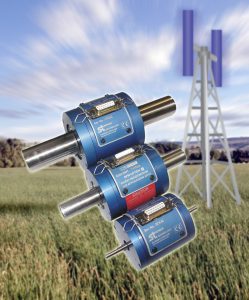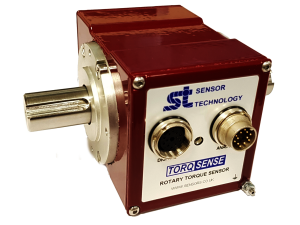Performing scientific experiments in the sort of winds and weather conditions that blow off the North Sea and across the Northumbrian hills, calls for robust equipment and reliable researchers.
When scientists wanted a way of measuring the key parameters for mapping the performance of vertical axis turbines sited in the very North East of England, they turned to Sensor Technology’s TorqSense rotary torque transducer to form the heart of their monitoring system.
V ertical axis wind turbines are enjoying a revival of popularity, as they are now understood to offer a number of advantages over the more conventional propeller-type horizontal axis generators. They tend to be quieter and safer as the leading edges of the rotor cannot exceed the wind speed. Additionally they do not need to be turned to face into the wind (this ‘yawing’ can be almost constant and absorbs a considerable amount of power that would otherwise be converted into useful electricity), and their design and construction is relatively simple because there are few unbalanced or overhanging loads. Finally, they are considered by many people to be less visually obtrusive in sensitive landscapes.
ertical axis wind turbines are enjoying a revival of popularity, as they are now understood to offer a number of advantages over the more conventional propeller-type horizontal axis generators. They tend to be quieter and safer as the leading edges of the rotor cannot exceed the wind speed. Additionally they do not need to be turned to face into the wind (this ‘yawing’ can be almost constant and absorbs a considerable amount of power that would otherwise be converted into useful electricity), and their design and construction is relatively simple because there are few unbalanced or overhanging loads. Finally, they are considered by many people to be less visually obtrusive in sensitive landscapes.
Roy Wirachai, a researcher at the University of Northumbria’s Mechanical Engineering Department is undertaking a programme to analyse the performance of various types of vertical axis turbines. He has just presented papers at international conferences in Paris and Madrid detailing some of his finding based on last winter’s weather conditions, as monitored by a TorqSense unit.
“We used an out of season caravan park as one of our local test sites,” he told the assembly, “because we wanted a consistent wind profile.”
Here he set up a Darrieus-type turbine and ran it for a week. This proved able to self-start at wind speed about 4m/sec and to rotate at 50rpm in wind speed of 7m/sec. Data was generated via the RPM pick up of a TorqSense transducer and recorded using the related Sensor Technology measurement devices. Torque was also measured by the transducer, while other data such as wind speed were logged by suitable instruments.
Like horizontal axis wind turbines, vertical axis units can be scaled to virtually whatever size is required. Yachtsmen can mount a small one at the top of the mast or on the coachroof; likewise householders are being offered units about the size of a chimney, while development of a 3MW behemoth for mains supply is well underway.
“Ultimately we are trying to establish power coefficients and optimised design,” says Roy. “It’s painstaking work, so I am delighted that the TorqSense has always performed perfectly, taking accurate measurements and never failing – not even after weeks on a caravan site in February.”





